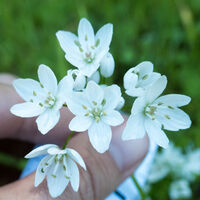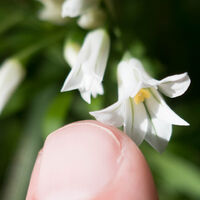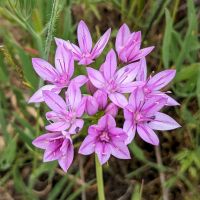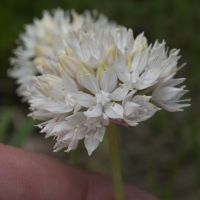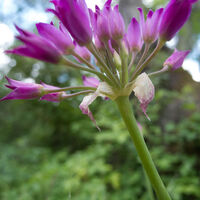onions
genus Allium
Member of
amaryllis family (family Amaryllidaceae)
monocots (class Liliopsida)
flowering plants (subphylum Angiospermae)
Except for old historical records and extremely rare examples that I don't expect to encounter, there are no other wild species of this genus in the bay area.
Caution: The key to distinguish these species is not complete.
A major distinguishing feature is the outer bulb coat cell structure. So an ID may be impossible without digging up a plant.
Other key features:
- number of leaves per stem (1, 2, or more)
- leaf sickle-shaped or not
- leaf flat, channeled (curved), or cylindric (curled)
- stem winged (above) or not
- number of ovary crests [not visible in photos]
- pedicel length
- flower length, shape
- inner perianth parts dentate, serrate, or not
All onions can be pink/purple to white, so color is not a strong ID feature.
1–2 leaves per stem, flat or channeled, sickle-shaped
1 cylindric leaf per stem
fringed onion
Allium fimbriatum
- flowers 8–12 mm
- dark red-purple to white perianth parts
- Henry Coe
serpentine onion
Allium diabolense
- flowers 6–10 mm
- white perianth parts with pink midveins or tips
- very rare
2+ leaves per stem, not sickle-shaped
The Jepson key for these uses bulb characteristics. TBD.
Allium triquetrum
- leaf 2–3, ± = stem, flat
- infloresence generally ± 1-sided
- pedicels 15–25 mm
- flowers 10–18 mm, pendent, bell-shaped
- perianth parts lanceolate, entire
- ovary crest 0
- more common
Allium unifolium
- leaf 2–3, < stem, widely channeled or ± flat, keeled
- pedicels 15–40 mm
- flowers 11–15 mm
- perianth parts ascending, ovate to obovate, entire
- ovary crests 6 longitudinal ridges [not visible?] [listed as crestless here]
- common
bolander’s onion
Allium bolanderi
- leaf 2–3, ± = stem, ± cylindric
- pedicels 10–20 mm
- perianth parts erect with spreading tips, ± lanceolate
- all perianth parts distally serrate [not visible in photos] with inrolled margins
- ovary crests 3, minute
- very rare
hooker’s onion
Allium acuminatum
- leaf 2–3, ± cylindric
- perianth parts 9–15 mm, spreading [but usually not in photos]
- inner perianth parts dentate [not visible in photos]
- Mt. Diablo
Allium amplectens
- leaf 2–4, ± cylindric
- perianth parts 4–9 mm, erect or spreading
- inner perianth parts entire
- uncommon
Toxicity of wild garlic, wild onion (Allium spp.):
1 – Skin contact with these plants can cause symptoms ranging from redness, itching, and rash to painful blisters like skin burns.
3 – Ingestion of these plants is expected to cause nausea, vomiting, diarrhea and other symptoms that may cause illness but is not life-threatening.
6 observed taxons / 8 unobserved taxons / 1 key
Locations: Months: For more details, use advanced search.
Chris’s observations: 36 (29 are research grade)
Taxon info: iNaturalist – Calflora – Jepson eFlora – FNA
Bay Area species: iNaturalist – Calflora
